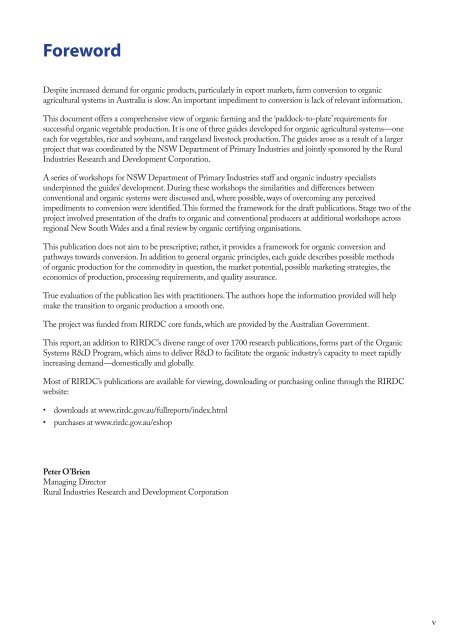4. Organic vegetable production
4. Organic vegetable production
4. Organic vegetable production
You also want an ePaper? Increase the reach of your titles
YUMPU automatically turns print PDFs into web optimized ePapers that Google loves.
Foreword<br />
Despite increased demand for organic products, particularly in export markets, farm conversion to organic<br />
agricultural systems in Australia is slow. An important impediment to conversion is lack of relevant information.<br />
This document offers a comprehensive view of organic farming and the ‘paddock-to-plate’ requirements for<br />
successful organic <strong>vegetable</strong> <strong>production</strong>. It is one of three guides developed for organic agricultural systems—one<br />
each for <strong>vegetable</strong>s, rice and soybeans, and rangeland livestock <strong>production</strong>. The guides arose as a result of a larger<br />
project that was coordinated by the NSW Department of Primary Industries and jointly sponsored by the Rural<br />
Industries Research and Development Corporation.<br />
A series of workshops for NSW Department of Primary Industries staff and organic industry specialists<br />
underpinned the guides’ development. During these workshops the similarities and differences between<br />
conventional and organic systems were discussed and, where possible, ways of overcoming any perceived<br />
impediments to conversion were identified. This formed the framework for the draft publications. Stage two of the<br />
project involved presentation of the drafts to organic and conventional producers at additional workshops across<br />
regional New South Wales and a final review by organic certifying organisations.<br />
This publication does not aim to be prescriptive; rather, it provides a framework for organic conversion and<br />
pathways towards conversion. In addition to general organic principles, each guide describes possible methods<br />
of organic <strong>production</strong> for the commodity in question, the market potential, possible marketing strategies, the<br />
economics of <strong>production</strong>, processing requirements, and quality assurance.<br />
True evaluation of the publication lies with practitioners. The authors hope the information provided will help<br />
make the transition to organic <strong>production</strong> a smooth one.<br />
The project was funded from RIRDC core funds, which are provided by the Australian Government.<br />
This report, an addition to RIRDC’s diverse range of over 1700 research publications, forms part of the <strong>Organic</strong><br />
Systems R&D Program, which aims to deliver R&D to facilitate the organic industry’s capacity to meet rapidly<br />
increasing demand—domestically and globally.<br />
Most of RIRDC’s publications are available for viewing, downloading or purchasing online through the RIRDC<br />
website:<br />
• downloads at www.rirdc.gov.au/fullreports/index.html<br />
• purchases at www.rirdc.gov.au/eshop<br />
Peter O’Brien<br />
Managing Director<br />
Rural Industries Research and Development Corporation

















